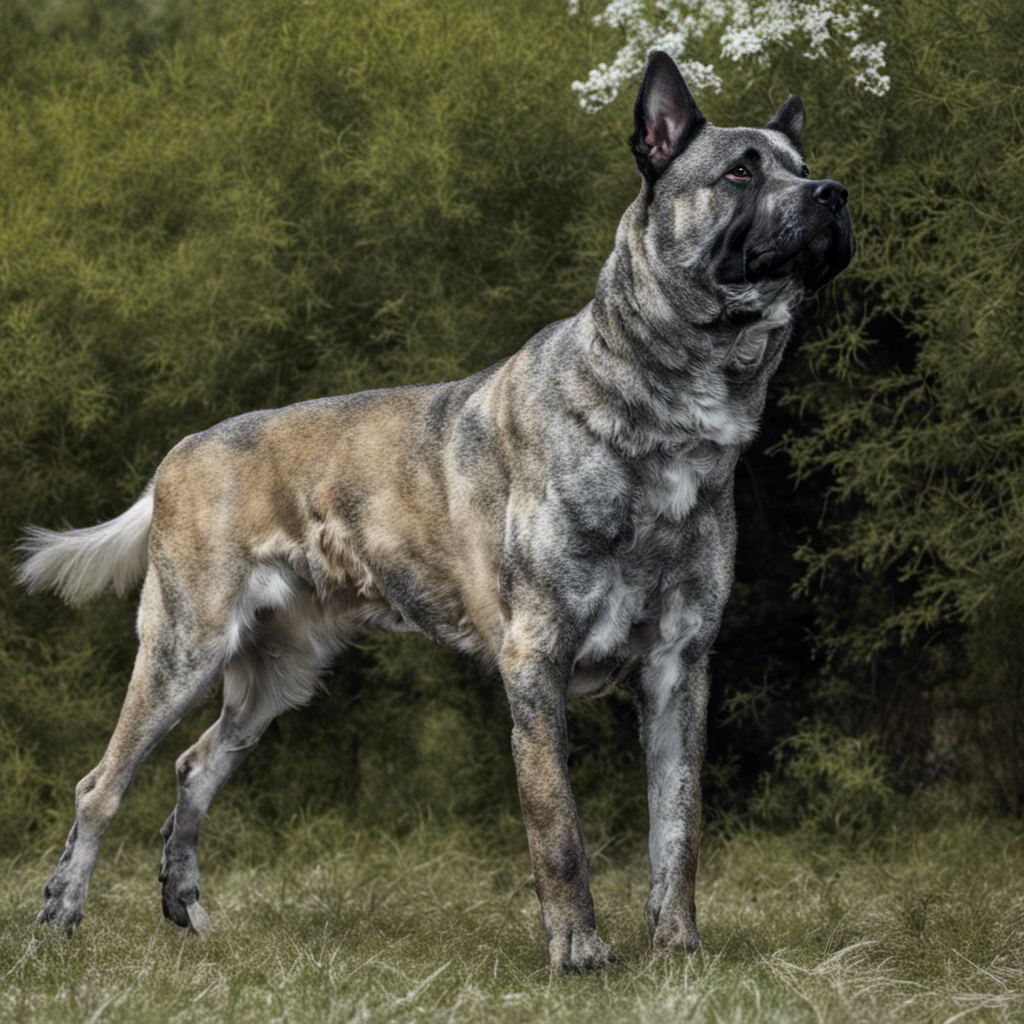Click and GO TO THE BEST DOG NAME GENERATOR HERE

The Dogo Sardesco, known for its loyalty and protectiveness, is a breed that exhibits distinct physical characteristics and temperament traits.
With prominent jaws, a black nose, round amber eyes, and traditionally cropped ears, they come in various coat colors, including red, brown, grey, black, and brindle, often with black masks.
While highly devoted to their families, caution is warranted when considering them for families with young children due to their suspicious nature towards strangers.
The breed excels as watch dogs and can display aggression as guard dogs. Training and socialization can help mitigate their various forms of dog aggression, but not eliminate them entirely.
Highly intelligent yet challenging to train, they respond best to dominant owners.
Adequate exercise, preferably 45 minutes to 1 hour daily, is necessary, making a large yard preferable to apartment living.
Grooming requirements are minimal, and the breed generally enjoys good health, although genetic testing is advisable to identify potential conditions.
This article will explore the physical characteristics, temperament, training and intelligence, as well as health and care considerations associated with the Dogo Sardesco breed.
Key Takeaways
- The Dogo Sardesco is a breed known for its physical characteristics such as prominent jaws, round amber eyes, and a serious expression.
- They have a range of coat colors and patterns, with red, brown, grey, black, and brindle being the most common.
- The breed is extremely loyal and devoted to its family but may not be suitable for families with young children due to their suspicious nature towards strangers.
- The Dogo Sardesco exhibits various forms of dog aggression and requires proper training and socialization to manage this behavior.
Physical Characteristics
The physical characteristics of the Dogo Sardesco include:
- Prominently developed jaws
- A black nose which may vary depending on coat color
- Traditionally cropped ears of small to medium size
- Round amber eyes
- A serious and intense expression
This breed is known for its:
- Powerful and muscular build
- Robust appearance
- Strong and well-proportioned body
- Deep and broad chest
- Straight and sturdy back
- Well-developed hindquarters
The breed’s coat comes in various colors such as:
- Red
- Brown
- Grey
- Black
- Brindle
Some individuals may have black masks. These physical characteristics are essential to the Dogo Sardesco’s overall appearance and contribute to its ability to carry out its duties as a loyal and protective guardian.
Temperament and Behavior
Extensive training and socialization are necessary to manage the strong territorial instincts and wary nature exhibited by the Dogo Sardesco. This breed is extremely loyal and devoted to their family, but they are not recommended for families with young children due to their cautious and protective nature.
They are highly suspicious of strangers and require proper training to prevent aggressive behavior. The Dogo Sardesco is an excellent watch dog and a fierce guard dog. While they may exhibit various forms of dog aggression, training and socialization can help reduce but not eliminate this tendency.
They generally do best as the only dog in the household or with a single member of the opposite sex. Additionally, they are less animal aggressive and tend to be protective over livestock.
It is important to note that the Dogo Sardesco requires a patient and dominant owner, as they are highly intelligent but challenging to train.
Training and Intelligence
Training and socialization are essential for managing the strong territorial instincts and wary nature exhibited by the Dogo Sardesco. This breed requires a patient and dominant owner to effectively address their high intelligence and stubbornness.
Due to their intelligence, Dogo Sardescos can be challenging to train. They are known to be stubborn and easily bored, so training sessions should be engaging and varied to maintain their interest. Consistency, firmness, and positive reinforcement techniques are key to successful training.
It is important to establish dominance and leadership in the owner-dog relationship to gain their respect and cooperation. Mental stimulation is equally important as physical exercise, as these dogs have a high energy level and require both to prevent boredom and destructive behavior.
Providing them with tasks, such as obedience training or puzzle toys, can help channel their intelligence and energy in a positive direction.
Health and Care
Health and care considerations for the Dogo Sardesco include regular testing for potential genetic conditions and monitoring skeletal and visual health. Limited health studies have been conducted on this breed, but it is generally considered relatively healthy with lower rates of common health problems. However, skeletal and visual problems may occur, making testing recommended for potential genetic conditions. The Orthopedic Foundation for Animals (OFA) recommends testing for skeletal health, which can identify potential health defects before they show up and is valuable for detecting conditions in advanced age. Additionally, the Canine Eye Registration Foundation (CERF) recommends testing for visual health, which is important for breeding to prevent genetic conditions in offspring. By implementing these testing protocols, breeders and owners can ensure the overall health and well-being of the Dogo Sardesco breed.
| Health Testing Organization | Recommended Testing | Purpose |
|---|---|---|
| Orthopedic Foundation for Animals (OFA) | Skeletal health testing | Identify potential health defects in advance |
| Canine Eye Registration Foundation (CERF) | Visual health testing | Prevent genetic conditions in offspring |
Frequently Asked Questions
What is the average lifespan of a Dogo Sardesco?
The average lifespan of a Dogo Sardesco is around 10 to 12 years.
However, it is important to note that individual lifespans can vary depending on various factors such as genetics, overall health, and quality of care provided.
Regular veterinary check-ups, a balanced diet, exercise, and a safe living environment can contribute to a longer and healthier life for this breed.
Are Dogo Sardescos prone to any specific allergies?
Dogo Sardescos are not known to be prone to any specific allergies. However, it is important to note that individual dogs can have sensitivities or allergies to certain foods, environmental factors, or substances.
If a Dogo Sardesco shows signs of allergies such as itching, redness, or gastrointestinal issues, it is recommended to consult with a veterinarian to determine the cause and provide appropriate treatment or dietary adjustments.
Regular veterinary care and a balanced diet can help maintain the overall health of the breed.
How does the Dogo Sardesco interact with other household pets?
The Dogo Sardesco is known to have a complex relationship with other household pets. Due to its history as a guardian and protector of livestock, the breed can exhibit aggression towards other animals, especially those of the same sex.
While some individuals may coexist peacefully with other pets, it is generally recommended that the Dogo Sardesco be the only pet in the household or be paired with a member of the opposite sex. Proper training, socialization, and supervision are crucial in managing the breed’s interactions with other pets.
Can a Dogo Sardesco be left alone for long periods of time?
A Dogo Sardesco should not be left alone for long periods of time. This breed is highly loyal and devoted to their family, and they require constant companionship. Leaving them alone for extended periods can lead to separation anxiety and destructive behavior.
It is important to provide them with mental and physical stimulation, as well as regular exercise and socialization. Consider hiring a dog walker or providing them with interactive toys if you are unable to be home with them throughout the day.
Are there any specific dietary requirements for a Dogo Sardesco?
There are no specific dietary requirements for the Dogo Sardesco breed.
However, like all dogs, they require a balanced diet that includes high-quality protein, healthy fats, and carbohydrates.
It is important to consult with a veterinarian to determine the appropriate portion sizes and specific nutritional needs based on the dog’s age, weight, and activity level.
Providing a consistent and nutritious diet is essential for maintaining the overall health and well-being of the Dogo Sardesco.


